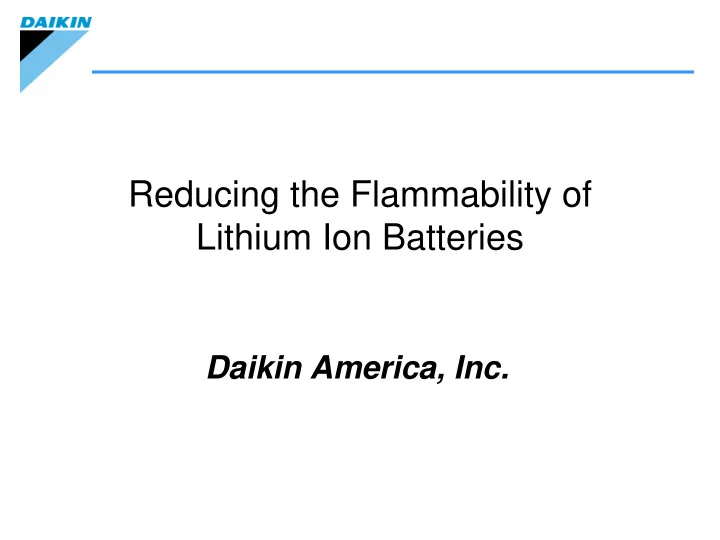

Daikin Confidential Reducing the Flammability of Lithium Ion Batteries Daikin America, Inc. 1 1 1 1 1 1 1 1 1 1
Daikin Confidential Fire Safety of Lithium Ion Batteries a Concern • The Fire Safety of Lithium ion Batteries (LiB) has been a concern since their initial adoption. • LiB fires in laptops • UPS Boeing 747 crash in 2010 blamed on LiB fire • EV battery fires – Chevrolet Volt and Fisker Karma • LiB development work has focused on improving energy density, power, and increasing battery life. • Fire safety has been addressed by improving auxiliary support systems • Little work done on improving the fire safety of the LiB cells until now. • Daikin America – A global leader in fluorochemical products, has developed electrolyte chemistry that greatly increases the fire safety of LiB’s . 2 2 2 2 2 2 2 2 2 2
Daikin Confidential Root Causes of Fire in LiB Batteries LIB model reaction Charging reaction using hydrocarbon (ie. flammable) electrolyte LiCoO 2 + C + electrolyte CoO 2 + C x Li + electrolyte fuel oxidizer ignition source – heat, spark A charged conventional lithium battery contains fuel (electrolyte), an oxidizer (active), and multiple possible ignition sources. 3 3 3 3 3 3 3 3 3 3
Daikin Confidential Fire Mitigation Strategies in LIB Cells Using safer actives – remove oxidizer. • Myth: using LiFePO 4 cathodes eliminate fires in lithium ion batteries. Would not fully eliminate fire possibility . • Report DOT/FAA/AR-09/55 clearly indicates extreme fire hazard still possible due to the presence of flammable electrolyte even using LiFePO 4 Minimize ignition sources through engineering controls – remove ignition. • May identify causes but flammable fuel still present. Eliminate flammability of electrolyte – remove fuel. • Render electrolyte non flammable through chemistry. • Replacing the flammable electrolyte (fuel) is the ONLY strategy for preventing fire. 4 4 4 4 4 4 4 4 4 4
Daikin Confidential Burst Test and Flammability Testing at independent laboratory shows flammability eliminated/reduced with added 20% fluorochemical content. Burst testing was completed using 18650 cells using hot wire ignition source. SADK -01 Conventional electrolyte SADK-03 Daikin electrolyte (20% wt fluoroadditive 5 5 5 5 5 5 5 5 5 5
Daikin Confidential Burst Test and Flammability Results Numerical test results with some typical electrolyte hydrocarbon mixtures (1 st four) shown for comparison. time until flame temperature ignition duration at vent burst 6 6 6 6 6 6 6 6 6 6
Daikin Confidential Overcharge Test - Daikin Addition of D7 fluorochemical enhances safety upon overcharge. LFP / artificial graphite, 3.6V, SOC=100%, 1 C 12V overcharge ( 10Ah laminate cell ) A. 1.0M LiPF6, EC/EMC=30/70 3 hrs. explosion B. 1.0M LiPF6, EC/EMC/ D7 =30/60/10 no 3 hrs. explosion 7 7 7 7 7 7 7 7 7 7 7
Daikin Confidential Cycling Behavior In separate independent laboratories, Daikin electrolyte also containing 20% fluorochemical shows superior cycling behavior compared to conventional hydrocarbon electrolyte. Note cycle number on x axis. Fluorinated electrolyte increases cycle life by more than a factor of 2 down to 70% retention. 8 8 8 8 8 8 8 8 8 8 8
Daikin Confidential Conclusions / Future Prospects Fires in lithium ion cells are due to interaction of electrolyte (fuel), active (oxidizer) and spark/heat (ignition source). Most viable safety solution is elimination of flammable electrolyte. Daikin America produces electrolyte with fluorinated additives which: Show enhanced safety – no flammability Demonstrate improved cycle performance – greater battery lifetime Have been verified in-house and in independent laboratories A safe and reliable Lithium ion battery can be engineered using such an electrolyte. 9 9 9 9 9 9 9 9 9 9
Recommend
More recommend